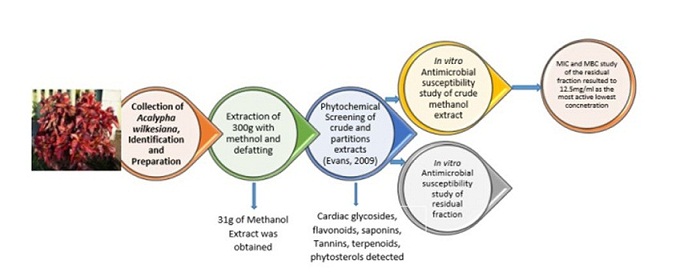Document Type : Original Research Article
Authors
- James Yakubu 1
- Sodipo Adebola Olufunke 2
- Umar Tanko Mamza 1
- Juliet Musa Atiji 1
- Abiso Saidu Musa 1
- Faisal Ahmad 1
- Idris Hassan 1
1 Department of Pure and Applied Chemistry, Faculty of Science, University of Maiduguri, Maiduguri, Borno State, Nigeria
2 Department of Clinical Pharmacology & Therapeutics, Faculty of Basic Clinical Sciences College of Medical Sciences, University of Maiduguri, Maiduguri, Nigeria
Abstract
This research aimed to investigate in vitro antimicrobial property of Acalypha wilkesiana against some selected pathogenic microbes that are resistant to drugs. The crude and defatted methanol extracts were screened for the presence of secondary metabolites as well as analysed for in vitro antimicrobial activity using agar-well diffusion method. The phytochemicals in the leaf include flavonoids, terpenoids, carbohydrates, tannins, saponins, cardeinolides, and cardiac glycosides. The methanol leaf extract showed activity against some microbes in a concentration-dependent manner, with highest inhibition zone against Salmonella typhi (24.67±0.33mm) at 500 mg/ml with insignificant difference as compared with to the inhibition zone of the standard drug, Ciprofloxacin (20 mg/ml) [25.00±0.57] and the lowest zone of inhibition against Streptococcus pyogenes, Bacillus subtilis, Salmonella typhi, and Klebsiella pneumoniae had the least zones of inhibitions of 7.00±0.00, 7.00±0.00, 7.00±0.00, and 8.00±0.00, respectively, at 100 mg/ml. S. aureus, E. coli, and C. albicans had no zones of inhibition and no zone of inhibition shown at any concentrations on Aspegillus niger. The antimicrobial susceptibility test shows that Acalypha wilkesiana had the highest activity against C. albicans (19.00±0.57), while no activity against Escherichia coli and Klebsiella pneumonia. Although the residual portion had the best antimicrobial effect, thus, this study has provided guide that the compound(s) responsible for the antimicrobial effect could be polar in nature.
Graphical Abstract
Keywords
Main Subjects
- K. Mukherjee, An approach to evaluation of botanicals. In: Quality control of herbal drugs. Business Horizons (2002)16-23.
- Odugbemi, A textbook of Medicinal plants from Nigeria. University of Lagos press, Lagos, Nigeria; (2008) 9-16.
- H.O, World Health Organization. The World health report: Making a difference. World Health Organization. (1999).
- M. Hasler, J.B. Blumberg, Symposium on phytochemicals: Biochemistry and physiology. Journal of Nutrition, 129 (1999)756S-757S.
- L. Gibson, J. Wardel, C.J. Watts, Fruit and vegetable consumption, nutritional knowledge and beliefs in mothers and children. Appetite, 31 (1998) 205-228.
- Mathai, Nutrition in the adult years. In: Krause’s Food, Nutrition, and Diet Therapy, 10th Edition. L.K. Mahan and S. Escott-Stump, 271 (2000) 274-275.
- C.S, American Cancer Society. Phytochemicals. available at http://www.cancer.org /eprise/main /docroot/ETO/content/ETO_5_3X_phytochemicals, June 2000.
- S. Makoshi, O.O. Oladipo, J.G, Gotep, G.E. Forcados, M.L. Shu, Safety evaluation of Acalypha wilkesiana in albino rats and BHK-21 cell line. Comparative Clinical Pathology, 25 (2016) 1618-5641.
- O. Akinyemi, O. Oladapo, C.E. Okwara, C.C. Ibe, K.A. Fasure, screening of crude extracts of six medicinal Plants used in South-West Nigerian unorthodox medicine for antimethicillin resistant Staphylococcus aureus activity. BMC Complementary Alternative Medicine. 5 (2005) 1-6.
- H.O. World Health Organization. Antimicrobial Resistance. (2021). Https:// https://www.who.int/news-room/fact-sheets/detail/antimicrobial-resistance. Retrieved on 12-10-2022.
- Yakubu, Y.B. Usman, M.V. Balami, N. Jonathan, Y. Semiu, D.M. Teri, Phytochemical and elemental analysis of some organic solvent leaf extracts of Piliostigma thonningii (Schumach) Milne-Redhead Ewemen Journal of Folklore Medicine, 2 (2016) 49-57.
- Usman, F.I. Abdulrahman, A. Usman, Qualitative phytochemical screening and in vitro antimicrobial effects of methanol stem bark extract of Ficus thonningii (Moraceae). African Journal Traditional Complement Alternative Medicine, 6 (2009) 289-95.
- Vollekovà, D. Kòst’àlovà, R. Sochorovà, Isoquinoline alkaloids from Mahonia aquifolium Stem bark is active against Malassezia spp. Folia Microbiology, 46 (2001) 107-111
- Yakubu, C.A. Maina, L. Haruna, S.I. Dawa,, S. Ibrahim,, U.T. Mamza,, F.I. Abdulrahman, O.A. Sodipo, Phytochemical and antimicrobial potential of methanol root bark extract of Boswellia dalzielii. Chemsearch Journal, 13 (2022) 76-80.
- Awe, I. Eme, Antibacterial activity and phytochemical screening of Acalypha wilkesiana (Copper Leaf) leaf extract on some clinical isolates. Research Journal of Pharmaceutical, Biological and Chemical Sciences. 5 (2014) 1-7.
- O. Aladejimokun, K.M. Daramola, O.J. Osabiya, O.C. Arije, Comparative study of phytochemical constituents and antimicrobial activities of Acalypha wilkesiana and Acalypha godseffiana Extracts. Journal of Advances in Microbiology. 4(1) (2017) 1-7.
- Madziga, S. Saka, U.K. Sandabe, Phytochemical and elemental analysis of Acalypha wilkesiana leaf. Journal of American Science. 66 (2010) 510-514.
- Omage, A.M. Azeke, I.I. Ihimire, A.M. Idagan, Phytochemical, proximate and elemental analysis of Acalypha wilkesiana leaves. Scientific Journal of Pure and Applied Sciences. 2 (2013) 323–31.
- Omage, A.M. Azeke, Medicinal potential of Acalypha wilkesianaleaves. Advances in Research, 2 (2014) 655–65.


.jpg)
